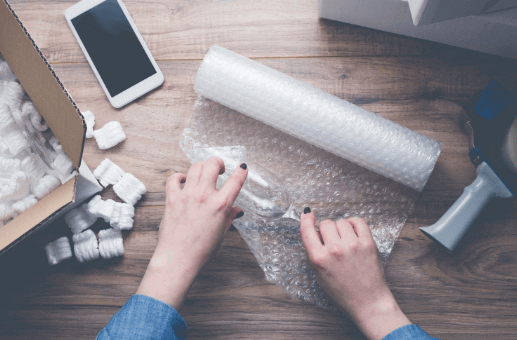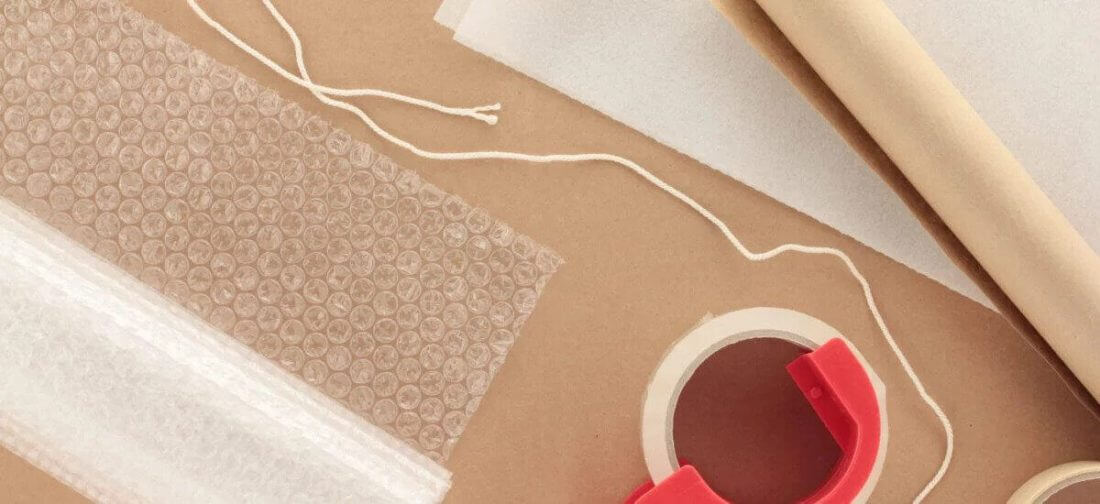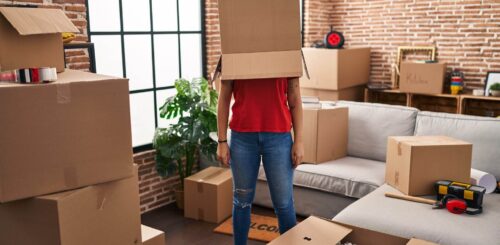Have you ever wondered how to use bubble wrap when relocating in a way that fully utilizes its protective potentials? It might seem rather simple – you take an item, bundle it, and you are all set. But there are so many things to think about if you want your objects to be perfectly safe during a long-distance move.


Think about the different types of this material, its size, and how you can cover and protect your belongings with it. If you are not up for doing it yourself, hire a reliable moving company to help you handle everything.
But no matter who handles your things, they will need it due to the many advantages that make it one of the best padding materials when it comes to protecting your items. We offer some handy information and instructions on how to properly use this incredible material.
What Kind of Items Should You Pack
When you have the right materials, you can box up almost anything. Bubbles can be used to protect every item you don’t want to get damaged during the relocation. For example, if you are about to pack your vacuum cleaner or your fishing rod, it is possible to protect them with bubble wrap.
When you hire professional packing services from Long Distance USA Movers, we’ll bring the necessary materials and ensure all your belongings are bundled in them. Now, let’s move on to some of the most common household items that can be properly protected with this versatile and highly durable material.
Use Bubble Wrap for Moving Fragile and Delicate Objects
Once you make a home inventory, you will see how many fragile and delicate things you actually have. Having too many breakable or valuable things to transport to another state might lead to a fear of moving. But all you have to do is choose the right packing strategy and ensure that your objects are as safe as possible.
If you find a top-notch moving company like Long Distance USA Movers to assist you with the move, our crew will bring all the necessary boxes and packing materials to protect your fragile belongings. Our cross-country moving services cover numerous beneficial aspects.
But, if you want to pack by yourself, you might be wondering if you should choose bubble wrap or packing paper. Use both instead for double protection. They are there to help you prepare mirrors for the move or be put around dishes. If you are moving a grandfather clock, you should consider using that as well.
Using Packing Bubble Wrap for Furniture
Putting this material around your bulky furniture seems expensive. If you want to save up, use it on some more breakable parts of your belongings. Maybe you have glass items in your home that need additional care, like glass tabletops, shelves, and cabinets. You can remove them from the rest of the sturdy furniture parts and then box them up.
The same goes for door handles, knobs, and other mobile furniture parts. When you disassemble pieces of furniture, it will be easier to move them. Professional movers are equipped to handle all kinds of heavy items, but if you are doing all the heavy lifting, transporting your items in parts will make the process way easier.
Where to Get Bubble Wrap and Using the Right Materials and Techniques
Whatever material you are using to protect your belongings, you need to know how to get the most out of it. You also need to learn where you can get materials that could benefit your move.
Most packing materials, especially bubble wrap, are available at hardware and home stores; you can also buy it from a supply company or simply allow a long-distance moving company to pack everything for you in their equipment.
You can choose one of several types of bubble wrap; this selection typically includes:
- Large wraps can be as big as 1’’ in diameter, and they are used for bulky household items and padding,
- Smaller wraps are the most common, and their size is 3/8’’. They protect against impacts, shocks, and scratches. You can use them to pack china, electronics, or other delicate items,
- Anti-static are designed to protect electronic objects, so if you are boxing up phones, laptops, or TV you should consider this type of material. It dissipates the static charge, and it protects the electronic chips,
- Envelopes are created to protect books, small pictures, and CDs,
- There are many specialized wraps as well.
One of the Most Important Packing Questions – Bubbles in or Out? Learn How to Wrap a Picture Frame
Have you actually asked yourself this? If you are wondering what the right answer is, the past experiences of packers suggest that you should put air-filled balloons inwards. They should face the objects they are protecting, for many reasons:
- Patterns help with fixating the object in one place,
- A bubble can provide excellent cushioning,
- They can adapt to the shape of the objects,
- The flat side provides better protection from external impacts.
Secure the Bubble Wrap Tightly
Bubble wrap can sustain shocks and hits, and it protects in case of collision. If you want to make sure it stays around your belongings, you need to secure it in place. Having an insurance policy is excellent, but make sure you do everything to prevent your belongings from breaking.
Don’t make the mistake of applying duct tape on only one side of the wrapped package. Fix the packaging with tape on all sides. This will eliminate the chance of your item slipping out. Apply wide-diameter tape if you can – it is stronger and more efficient.
This is essential when you are using a storage service. You will want to have your items wrapped in padding and insulation materials which will protect them from moisture or wetness during their stay in the facility.
Extra Protection When Moving – Padding
Layers and layers of this material can only mean one thing – your belongings will be safely tucked away in boxes and fully prepared for a long-distance trip.
Padding is an essential part of the packing process, and what better material than bubbles to sustain hits and shocks? So, if you have too much empty space in the box, don’t forget to put some bubbles, paper, and peanuts there.


Advantages of Knowing How to Use Bubble Wrap for Packing
When using one of the most practical packing materials, you should know that it comes with many advantages and benefits. It provides cushioning, and it fits any shape. Additionally, it is:
- Safe – offers excellent protection,
- Convenient – it is one of the easiest materials to handle, all you need is to put it around the item you want to protect,
- It is budget and environment-friendly – it is light, so it doesn’t add up too much on the weight of your belongings, and it can be reused a few times,
- Fun – you surely popped a few bubbles, and you have to admit it can be fun.
No matter how much bubble wrap you apply, make sure that everything is put into place, sealed, and labeled. Even though this is one of the best packing materials, using it is just one of the preconditions of a successfully executed move.


Contact Long Distance USA Movers to Help You Use Bubble Wrap for Moving
If you feel like panic is overtaking you when you plan your move, contact a professional long-distance moving company for help. That’s going to save you a lot of trouble – from packing to truck loading and unloading. That can also include car shipping services for the ultimate experience.
We at Long Distance USA Movers also offer some relocation benefits that make the process easier and better. With us, you can get free storage service for a month, to safely keep your belongings in a temperature-controlled, secured location.
There’s also relocation insurance involved to take away all your worries when it comes to getting the safest and best transport possible.
Frequently Asked Questions About How to Use Bubble Wrap
What Is Bubble Wrap?
Bubble wrap is a pliable plastic packaging material that is commonly used for protecting fragile items during shipping or storage. It features small air-filled bubbles that provide cushioning and shock absorption.
The bubbles are typically clear, although they may be colored, and come in various sizes and thicknesses. Bubble wrap can also be used for stress relief or as a sensory tool due to the satisfying sensation of popping the bubbles.
How Can I Use Bubble Wrap to Protect Fragile Items During a Move?
Bubble wrap can be used to protect fragile items during a move by wrapping the item in several layers of bubble wrap and securing it with tape. Here are some steps to follow:
- Cut a piece of bubble wrap that is large enough to cover the item completely,
- Wrap the item with a layer of bubble wrap, securing it with tape,
- Add additional layers of bubble wrap, paying extra attention to any delicate areas or corners,
- Once the item is fully wrapped, secure the bubble wrap with tape, making sure it won’t come loose during the move,
- Label the package as fragile to ensure movers handle it with care.
It’s important to use enough bubble wrap to provide adequate protection for the item, but not too much so that it becomes too bulky or difficult to handle.
What Are the Different Types of Bubble Wrap Available?
There are several different types of bubble wrap available, including:
- Standard – the most common type, with small bubbles of uniform size and spacing.
- Large – features larger bubbles for added protection and cushioning.
- Anti-static – designed for use with electronic items to prevent static electricity damage.
- Colored – comes in a variety of colors and may be used for decorative purposes or to color-code items for organization.
- Biodegradable – made from eco-friendly materials that break down naturally over time.
Bubble wrap may also come in different thicknesses, ranging from thin and flexible to thicker and more durable. The type of bubble wrap needed will depend on the specific item being packaged and the level of protection required.
Can Bubble Wrap Be Reused?
Bubble wrap can be reused, although it may not be as effective after repeated use. To reuse bubble wrap, carefully remove it from the item it was protecting and inspect it for any tears or punctures.
If it is still in good condition, it can be used to protect another item. However, if it appears damaged or worn, it’s best to dispose of it and use a new piece to ensure adequate protection.
Additionally, consider donating reusable bubble wrap to local businesses or organizations to help reduce waste.
How Do I Choose the Right Size of Bubble Wrap for My Needs?
To choose the right size of bubble wrap for your needs, consider the size and fragility of the item you need to protect. Generally, smaller bubbles provide better cushioning for smaller, more delicate items, while larger bubbles provide more protection for larger items or those with irregular shapes.
Additionally, consider the thickness of the bubble wrap, as thicker options offer more durability and protection. It’s also important to consider how much bubble wrap is needed, as using too much can add unnecessary weight and volume to a package. Ultimately, choose the size of bubble wrap that best fits the item being protected while still being efficient and cost-effective.
Can Bubble Wrap Be Used for Packing Non-fragile Items as Well?
Bubble wrap can be used for packing non-fragile items as well, but it may not be the most cost-effective option. Using bubble wrap to pack non-fragile items may add unnecessary weight and volume to a package, increasing shipping costs.
Consider using other packing materials such as packing paper or air pillows for non-fragile items. However, bubble wrap can be useful for organizing and cushioning items within a package, helping to prevent shifting or damage during transit.
How Can I Wrap Items in Bubble Wrap to Ensure Maximum Protection?
To wrap items in bubble wrap to ensure maximum protection, follow these steps:
- Select a piece of bubble wrap that is large enough to cover the item completely,
- Wrap the item with a layer of bubble wrap, securing it with tape,
- Add additional layers of bubble wrap, paying extra attention to any delicate areas or corners,
- For particularly fragile items, consider using double-layered bubble wrap or wrapping the item in multiple pieces of bubble wrap,
- Once the item is fully wrapped, secure the bubble wrap with tape, making sure it won’t come loose during the move,
- Label the package as fragile to ensure movers handle it with care.
It’s important to use enough bubble wrap to provide adequate protection for the item, but not that it becomes too bulky or difficult to handle. Additionally, be careful not to compress the bubbles too much when wrapping the item, as this can reduce their cushioning ability.
Is It Necessary to Tape Bubble Wrap to Items or Boxes During a Move?
It is not always necessary to tape bubble wrap to items or boxes during a move, but it can provide added protection and help keep it in place. Taping bubble wrap to the item or box can prevent it from shifting during transit and reduce the risk of damage.
However, it is important to use tape sparingly and avoid taping directly to the item itself, as this can leave sticky residue or damage delicate surfaces. Instead, use tape to secure the bubble wrap around the item or to secure multiple layers together.
How Can I Use Bubble Wrap to Protect Electronic Devices During a Move?
Bubble wrap can be used to protect electronic devices during a move by following these steps:
- Remove all batteries from the device before packing,
- Wrap the device in a layer of anti-static bubble wrap, which is designed to prevent static electricity damage,
- Place the wrapped device in a box with additional bubble wrap or packing material to fill any empty space,
- Label the box as “Fragile” and “Electronic” to ensure movers handle it with care,
- For larger electronic devices, such as TVs or computer monitors, consider using a specially designed box with additional cushioning and protection.
How Can I Store Bubble Wrap After a Move?
To store bubble wrap after a move, remove any tape or labels from the bubble wrap. Inspect it for tears or punctures. If it is damaged, dispose of it and use a new piece for future use.
Fold or roll the bubble wrap neatly and store it in a dry, cool place away from direct sunlight or heat sources. Consider storing it in a plastic container or sealed bag to prevent dust or moisture from accumulating. Proper storage can help ensure the wrapping is in good condition for future use and help reduce waste.
Can Bubble Wrap Be Recycled?
Bubble wrap can be recycled, but it may not be accepted by all recycling programs. To recycle bubble wrap, check with your local recycling program to see if they accept it.
Some programs may require it to be dropped off at a special location, while others may accept it as part of curbside pickup. Additionally, consider donating reusable bubble wrap to local businesses or organizations to help reduce waste.
If recycling is not an option, bubble wrap can be disposed of in the regular trash.
How Can I Cut Bubble Wrap to the Correct Size for My Needs?
To cut the bubble wrap to the correct size, measure the area you need to cover and cut a piece that is slightly larger. Place the wrap with the bubbles facing up and use scissors or a utility knife to cut it to size, using them as a guide. Be careful not to pop the bubbles or tear the material. If the piece is large, fold it in half or thirds before cutting.
What Are Some Alternatives to Bubble Wrap for Protecting Fragile Items?
There are several alternatives to bubble wrap for protecting fragile items, including:
- Packing paper – crumpled packing paper can provide cushioning and shock absorption for fragile items,
- Air pillows – similar to bubble wrap, air pillows can be used to provide cushioning and protection,
- Foam sheets – foam sheets can be cut to size and used to wrap delicate items,
- Cardboard inserts – cardboard inserts can be used to separate and protect fragile items within a box,
- Packing peanuts – packing peanuts can be used to fill empty spaces within a box to prevent shifting during transit.
How Can I Label Boxes Containing Items Wrapped in Bubble Wrap?
To label boxes containing items wrapped in bubble wrap, use a permanent marker to write “Fragile” or “Handle with Care” on the box. This will alert movers or anyone handling the box to take extra precautions when moving it.
Additionally, consider labeling the box with a brief description of the item or contents, to help identify and prioritize fragile boxes during the move. It’s important to label boxes clearly and prominently, to avoid damage or confusion during transit.
Where Can I Purchase Bubble Wrap, and How Much Does It Typically Cost?
Bubble wrap can be purchased at office supply stores, shipping supply stores, or online retailers such as Amazon. The cost of bubble wrap varies depending on the size, thickness, and quantity purchased.
On average, a small roll of bubble wrap can cost between $5 to $10, while larger rolls or bulk purchases can range from $20 to $50 or more. Consider the quantity and size you should buy, as too much of it can add unnecessary cost and weight to your shipment.




